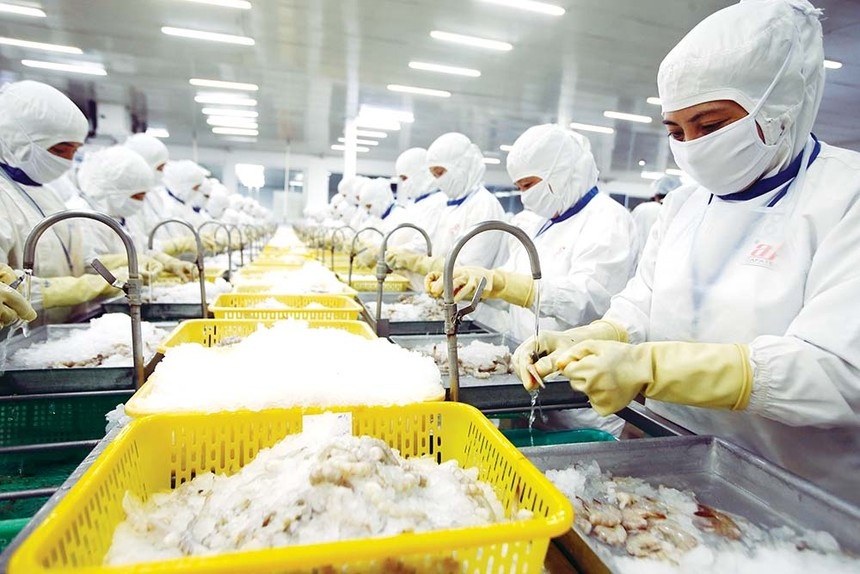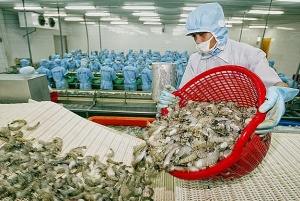Hard times for seafood exports
China’s reopening is beneficial to Vietnam’s fish exporters, as from 2020 China became Vietnam’s largest basa export market. The revenue stream from the Chinese market in 2023 is expected to make up for the shortfall from the US and EU where stubborn high inflation has adversely affected purchasing power.
The profit margin from the Chinese market, however, remains low due to the average price for the Chinese market often being 40 per cent lower compared to the US market.
 |
| The seafood sector aims to post $10 billion in total export value this year, down 9 per cent on-year |
Shrimp and basa fish hold the lion’s share in Vietnam’s seafood export structure in 2022, at 39.45 per cent and 38.53 per cent, respectively.
In the first two months of 2023, the total export value of basa fish just amounted to $240 million, down 38 per cent on-year. Analysts at SSI Research assume that the average basa export price this year will be from 20-30 per cent lower than in 2022.
Due to slow export orders and ample supply, basa exporters might incur negative profit this year despite falling aqua feed costs.
| Analysts at SSI Research assumed that the average basa export price this year might be 20-30 per cent lower than in 2022. |
For shrimp export, BIDV Securities estimate that the US and EU economies are forecast to be deep in difficulties in 2023, and this will affect shrimp consumption as shrimp products fetch high prices, and Vietnamese shrimp export products charge 10-15 per cent more than rival countries, such as Ecuador and India.
In February, Vietnam’s shrimp export amounted to $251 million, down 54.9 per cent on-year.
In the first two months of 2023, the total export value of shrimp products reached $335 million, a 40 per cent dip on-year, with export value to the US market falling 51 per cent, to Japan down 35 per cent, and to the EU down 46 per cent.
Ho Quoc Luc, chairman at Sao Ta Foods JSC, said that southwest localities are about to step up shrimp farming, but have encountered multiple hardships such as unfavourable weather and diseases.
If the shrimp crop is lost, the price will be brought to high levels in the world market, leaving exporters to count losses and face halting operation.
To weather the storm, Sao Ta Foods focuses on improving the price factor through applying cost-saving measures and boosting sale in markets in which it has advantages, such as Japan and Korea, while gradually breaking into the EU market.
In addition, the company aims to finalise developing new farming areas of 230ha in the second quarter of this year, bringing its total number of ponds to 600.
Meanwhile, Nam Viet Corporation (Navico), a large seafood firm based in southern An Giang province, hopes to boost sales to the Chinese market, which is expected to secure 45 per cent growth this year, becoming the company’s key growth driver.
Last year, Navico’s export revenue to China accounted for 18.5 per cent of the company’s total export value.
One of Nam Viet’s advantages is having spacious farming area of 850ha, and being self-sufficient in aquafeed, making it immune from rising material cost threats.
 | Sci-tech firms finding it hard to borrow Science and technology firms are still finding it hard to acquire bank loans, even though they are categorised among priority groups to borrow. |
 | Retailers flexibly steering through turbulent times Big retailers are adopting flexible measures to confront the challenging environment and consumers’ strict budgets. |
 | Seafood sector striving to expand export market As the markets are affected by economic fluctuations, many Vietnamese seafood enterprises have flexibly changed their strategy and boosted exports to niche markets. |
What the stars mean:
★ Poor ★ ★ Promising ★★★ Good ★★★★ Very good ★★★★★ Exceptional
Related Contents
Latest News
More News
- Opening remarks of 14th National Party Congress (January 20, 2026 | 09:44)
- First working day of 14th National Congress of Communist Party of Vietnam (January 19, 2026 | 08:54)
- Viettel starts construction of semiconductor chip production plant (January 16, 2026 | 21:30)
- Redefining Vietnam’s growth model for the era of innovation (January 16, 2026 | 16:40)
- Foreign sentiment towards Vietnam turns more positive (January 15, 2026 | 11:08)
- Vietnam ranks 38th in global AI adoption (January 14, 2026 | 16:01)
- European business confidence reaches highest in seven years (January 13, 2026 | 10:17)
- UOB lifts Vietnam growth outlook to 7.5 per cent for 2026 (January 10, 2026 | 09:00)
- Vietnam leads ASEAN in EV market growth (January 09, 2026 | 14:39)
- Electronics drive Vietnam’s trade growth as exports hit record in 2025 (January 07, 2026 | 10:23)

 Tag:
Tag:



























 Mobile Version
Mobile Version